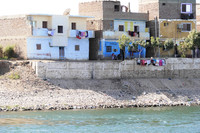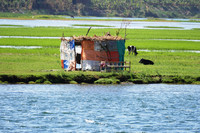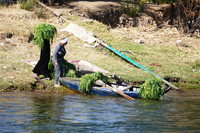By Glenda Winders
Historians are divided as to whether Cleopatra really sailed on a barge on the Nile, but if she didn't she really should have. She would have been missing a scenic adventure like no other as well as an understanding of why this river is so crucial.
At 4,132 miles long, the Nile narrowly edges out the Amazon as the longest river in the world. It originates in Burundi and runs north through 11 African countries before emptying into the Mediterranean. Seen from above, the river and its tributaries seem to blossom into a lotus flower at Cairo, so the lotus is Egypt's national flower. The opening and closing of the lotus flower symbolizes creation and rebirth, which is central to Egyptian spirituality. Papyrus, a main ingredient in paper, also comes from this significant river and grows plentifully in its southern marshes. Both are replicated in temple and tomb carvings throughout the country.
But the main reason the Nile is so important is that without it Egyptian civilization could not exist. The country sits at the northeast corner of the Sahara and has virtually no rain, so the spring floods that come from monsoons in Ethiopia and the fertile silt they leave behind are what make agriculture possible. Locals say Egypt has three seasons: flood, farming and harvest.
"It's our bloodline," said our guide, Sameh Samir, "the source of our lives."
Now that we knew all of this, my husband and I eagerly boarded a ship for our three-day cruise. The staff greeted us with glasses of hibiscus tea and suggested that the best views would be from the ship's top deck, but it was cool and windy there, and our cozy stateroom had the makings for cups of tea. We settled in there, opened the window so we could get clear pictures and hear the sound of the water, and watched life unfold on the banks of this ancient river.
Because of Egypt's Saharan location and dependence on the Nile, its nearly 100 million people live on 5% of the land, most of it along the river. That meant that we were able to see cities and towns — each with a towering minaret — people at work and play on the banks, and sand dunes beyond them in the distance.
We watched fishermen unfurl their nets and load their catch into small boats, farmers balancing huge sheaves of papyrus and other crops on their shoulders and heads. Women did laundry along the river and hung their clothes on lines or over the walls around their homes. Cattle grazed while their caretakers took to the shade in small shelters built for this purpose, and men walked their camels down dusty roads. Children sledded on collapsed cardboard boxes down small dunes, laughing in delight at this simple pleasure.
Our languorous people-watching was punctuated by visits to notable places and monuments along the way. One sunset stop was at Kom Ombo, where a double temple honors the crocodile god Sobek, both feared and respected because of his strength, and the falcon god Horus the Elder, who was thought to be in charge of the sky. On the way back to the ship we peeked in at the Crocodile Museum, where some of the facility's 300 mummified crocodiles found in this area were on display.
In Edfu we left the ship in the early morning dark and climbed into horse-drawn carriages that would transport us to the Temple of Horus. The drivers put on a dramatic show of racing one another through the narrow streets, which made for a harrowing ride but got us there in time for the sunrise. The temple is said to be the best-preserved in the country since it had been buried in sand and not rediscovered until 1900.
Back on the river we were entertained as we sailed by young men on small boats who hawked Egyptian cotton items by calling to passengers they could see in windows and out on deck: "Hey, mister, lookie, lookie!" They managed to sell several pieces, adroitly tossing them up as far as the ship's top deck and then catching the money their customers threw down to them.
Evenings there was entertainment inside, too. Because of the tour company we chose, our group traveled with a well-known Egyptologist who provided occasional lectures about the culture. During our cruise she talked about the influence of ancient art on contemporary as we sipped glasses of wine in the ship's lounge — the perfect way to end the day. The crew provided designer cocktails in the evenings before our buffet dinner, and all of the meals were a lively mix of Middle Eastern cuisine and Western favorites for the less adventuresome. The salad and bread tables alone were enough to provide a meal.
One evening we were treated to a belly-dancing exhibition, and another we were all invited to a galabeya party. Galabeyas are the dresslike pieces of clothing Egyptians wear for both work and play. A store on the ship sold glittery ones for anyone who didn't already have theirs. So adorned and with a small combo playing Egyptian music, we danced the night away.
WHEN YOU GO
In order to see and learn about everything Egypt has to offer, a guide is an absolute must. Google "tours of Egypt" and you'll find many at several different price points. We decided on Smithsonian Journeys and recommend them highly: www.smithsonianjourneys.org.


Glenda Winders is a freelance writer. To read features by other Creators Syndicate writers and cartoonists, visit the Creators Syndicate website at www.creators.com.
Farmers harvest their crops along the Nile River in Egypt. Photo courtesy of Phil Allen.







View Comments